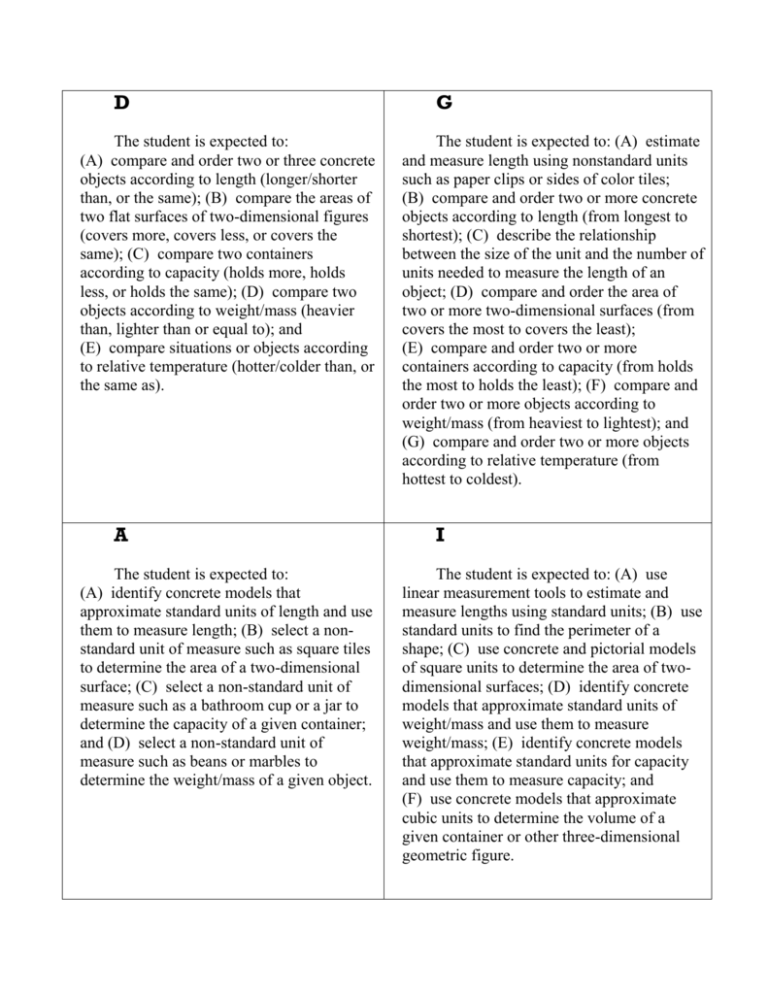Measurement TEKS Table
advertisement

D The student is expected to: (A) compare and order two or three concrete objects according to length (longer/shorter than, or the same); (B) compare the areas of two flat surfaces of two-dimensional figures (covers more, covers less, or covers the same); (C) compare two containers according to capacity (holds more, holds less, or holds the same); (D) compare two objects according to weight/mass (heavier than, lighter than or equal to); and (E) compare situations or objects according to relative temperature (hotter/colder than, or the same as). A The student is expected to: (A) identify concrete models that approximate standard units of length and use them to measure length; (B) select a nonstandard unit of measure such as square tiles to determine the area of a two-dimensional surface; (C) select a non-standard unit of measure such as a bathroom cup or a jar to determine the capacity of a given container; and (D) select a non-standard unit of measure such as beans or marbles to determine the weight/mass of a given object. G The student is expected to: (A) estimate and measure length using nonstandard units such as paper clips or sides of color tiles; (B) compare and order two or more concrete objects according to length (from longest to shortest); (C) describe the relationship between the size of the unit and the number of units needed to measure the length of an object; (D) compare and order the area of two or more two-dimensional surfaces (from covers the most to covers the least); (E) compare and order two or more containers according to capacity (from holds the most to holds the least); (F) compare and order two or more objects according to weight/mass (from heaviest to lightest); and (G) compare and order two or more objects according to relative temperature (from hottest to coldest). I The student is expected to: (A) use linear measurement tools to estimate and measure lengths using standard units; (B) use standard units to find the perimeter of a shape; (C) use concrete and pictorial models of square units to determine the area of twodimensional surfaces; (D) identify concrete models that approximate standard units of weight/mass and use them to measure weight/mass; (E) identify concrete models that approximate standard units for capacity and use them to measure capacity; and (F) use concrete models that approximate cubic units to determine the volume of a given container or other three-dimensional geometric figure. E The student is expected to: (A) estimate and use measurement tools to determine length (including perimeter), area, capacity and weight/mass using standard units SI (metric) and customary; (B) perform simple conversions between different units of length, between different units of capacity, and between different units of weight within the customary measurement system; (C) use concrete models of standard cubic units to measure volume; (D) estimate volume in cubic units; and (E) explain the difference between weight and mass. F The student is expected to: (A) estimate measurements (including circumference) and evaluate reasonableness of results; (B) select and use appropriate units, tools, or formulas to measure and to solve problems involving length (including perimeter), area, time, temperature, volume, and weight; (C) measure angles; and (D) convert measures within the same measurement system (customary and metric) based on relationships between units. C The student is expected to: (A) perform simple conversions within the same measurement system (SI (metric) or customary); (B) connect models for perimeter, area, and volume with their respective formulas; and (C) select and use appropriate units and formulas to measure length, perimeter, area, and volume. B The student is expected to: (A) estimate measurements and solve application problems involving length (including perimeter and circumference) and area of polygons and other shapes; (B) connect models for volume of prisms (triangular and rectangular) and cylinders to formulas of prisms (triangular and rectangular) and cylinders; and (C) estimate measurements and solve application problems involving volume of prisms (rectangular and triangular) and cylinders. H The student is expected to: (A) find lateral and total surface area of prisms, pyramids, and cylinders using concrete models and nets (two-dimensional models); (B) connect models of prisms, cylinders, pyramids, spheres, and cones to formulas for volume of these objects; and (C) estimate measurements and use formulas to solve application problems involving lateral and total surface area and volume. (D) use the Pythagorean Theorem to solve real-life problems; and (E) use proportional relationships in similar two-dimensional figures or similar three-dimensional figures to find missing measurements. (F) describe the resulting effects on perimeter and area when dimensions of a shape are changed proportionally; and (G) describe the resulting effect on volume when dimensions of a solid are changed proportionally.




